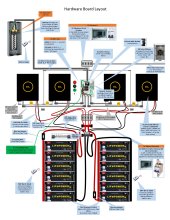You’re supposed to assemble then pull (I think it’s an NEC requirement). This prohibits you from using plumbing style elbows instead of sweeps. Also means you have to pop open the conduit bodies and use them as pull points.
Even prohibits using listed 90 elbows (I think those can only be used to terminate straight into a box, or as pull points).
Personally I will assemble while pulling as an expedient, if I know that I can pull again later but I can’t be bothered.
I don't understand reasons for those code requirements, but I know my physical limits. I was able to put 2/0 through 35' of 2" PVC with several 90 degree elbows this way, no equipment needed.
One way is you run an EGC and ground the frames to the overall grounding. And then the inverter would also be grounded.
Exactly.
I think there should be a wire from PV frames to chassis of EG.
We used to do that with a lug on each PV panel frame. Supposed to be able to remove panel, removing setscrew from wire but leaving ground wire connected to other panels.
Now often done with "WEEB" components which have toothed washers that bite into aluminum frames and mounting rails.
However.
The ground might need to go through the inverter for certain ground fault protection schemes where the inverter needs to see unexpected ground current. I don’t know if EG4 implements it, not all the cheap hybrids are diligent and up to code.
I'm not aware of any that measure current in ground. Just imbalance between hot/neutral (for AC), or use a fuse or breaker between PV- and ground; if enough current ~ 1A flows and trips that (due to fault in PV+ elsewhere), inverter sees the voltage and shuts off.
But you often can't stop fault current. So ground wire, like PV+ and PV-, should have ampacity = 1.56 x Isc, to handle the current continously.
Ground faults in solar arrays are kind of scary to me since they are high voltage and there’s no way to interrupt it from the inverter. Since the voltage is generated up in the array by the panels and wiring. Rapid Shutdown can help but I haven’t heard people talk about it here. I think a good inverter will look for evidence of a ground fault and warn you, even if it can’t stop the ground fault.
RSD here? A bunch of talk on the forum. Also AFCI. Because required by code in many parts of the US for anything with PV DC circuits in or on a building (exception for power shed.)
Arc fault meant to avoid fires due to series faults, which are common with incompatible MC4 compatible connectors.
RSD for fireman safety - open a switch and PV panels effectively disconnected from each other so < 80V anywhere.
RSD box may have MC4 connectors incompatible with those on PV panels (see above arcs.)
Photovoltaic compliance stinks ... you just can't win. (paraphrasing somebody)
Shock hazards is the first thing we want to prevent. Arcs starting fires the second. (or maybe battery fires; both have been an issue.)
I do like MC connectors (prefer MC3 over the cheap rolled sheetmetal MC4, but it looks like genuine Stabuli MC4 are good.) Before those were used, connecting PV panels meant putting a screwdriver on live 500VDC terminals. MC connectors are touch-safe, just be sure to interrupt current before mating/unmating. Now, the only live circuit we have to work on is battery terminals. I can think of ways to further mitigate that. Your server rack batteries are pre-assembled with shutdown controls, so already safe to handle.




